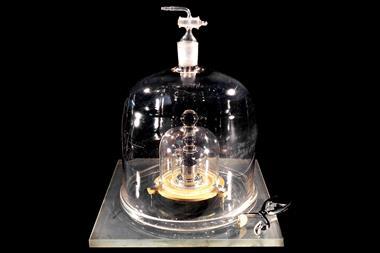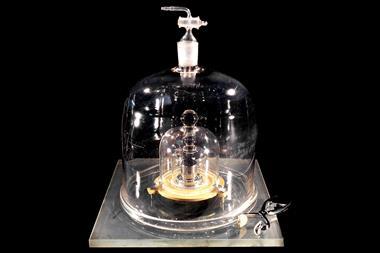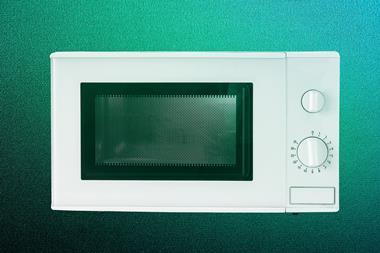![]()
Today marks the end of units of measurement as we know them. At a meeting in Versailles, France, representatives of 60 countries have unanimously agreed to overhaul the base units’ definition and, from now on, link them to fundamental laws of nature.
‘It’s a very exciting day, the whole measurement community has worked up to this day for the last 30 years,’ says JT Janssen, director of research at the National Physical Laboratory, the UK’s metrology institute. ‘It’s been such a long time coming, it’s really time to get on with it and start making new measurements.’
The decision has ended the reign of the king of kilograms, the 140-year-old platinum–iridium cylinder known as le grand K. The original kilogram is kept in a vault in Paris and all mass measurements on the planet can be traced back to it.
The système international d’unités, or SI, was conceived in 1875 to standardise measurement systems across countries and disciplines. It replaced the centimetre–gram–second system under which a confusing variety of units had sprung up over the course of the 19th century.
Seven base units – kilogram, metre, second, kelvin, ampere, mole and candela – make up the metric system. Although there is a historic aspect to choosing those seven over others, scientists designed the system to have as few base units as possible but still enough to derive all other units from.
Twenty-two SI-derived units have their own name, including the joule, volt, degree Celsius and newton. All others, like the metre per second unit for speed, simply retain their base unit names. ‘But once we redefined the SI units, the concept of base units disappears because we just have fundamental constants that every unit will be derived from,’ explains Janssen.
Since the metre bar became obsolete in 1960, the kilogram has remained the last unit dependent on a physical artefact. But as mass measurements became ever more nuanced, scientists started to worry about the cylinder’s mass changing. Even minute mass drifts – due to deposition of particles, for example – change the unit as a whole.
In 1999, metrologists agreed to link the kilogram to the Planck constant. As a quantum mechanical number derived from nature the constant will – or so it is hoped – be stable for the duration of the universe. At the same time, it was decided to also overhaul three other units – the ampere, the kelvin and the mole – and link them to natural constants.
While none of these units was in as dire need of changing as the kilogram, rewriting the definitions of these four core units of measurement will make them independent of specific experiments. The ampere’s old definition was based on an impossible to realise setup, while the kelvin and mole relied on specific substances (see box).
____________________________________
Explainer: Why is the kilogram changing?
____________________________________
Determining the constant’s numerical values with high accuracy and precision was at the core of metrologists’ efforts – once the values are included in definitions, they become unchangeable. Over the last decade, researchers have conducted sophisticated experiments, including counting atoms in a 1kg pure silicon sphere (for the mole’s redefinition), weighing objects with electromagnetic force (for the kilogram) and determining the speed of a helium atom using soundwaves (for the kelvin).
Despite the enormous efforts that have gone into the project, the units’ rewrite will make little difference in the real world. Only in some niche cases, like for ultra-high or ultra-low temperatures, will the new definitions simplify measurements.
The change will come into force officially on 20 May 2019 – World Metrology Day. In the meantime, scientists are already looking to the next redefinition. This time, they hope to tackle the second, using updated atomic clocks. ‘These tick one thousand times faster so you could make a clock that’s a thousand times more accurate,’ explains Janssen. ‘But the world of metrology moves very slowly so it’ll be at least another 10 years before this will happen.’
How do they shape up? The old units versus the new
Kilogram (kg) – mass
Old: defined by the mass of a metal cylinder – le Grand K – held in a vault in Paris
New: defined by the Planck constant h (6.626 070 15×10−34kgm2/s), a quantum mechanical quantity that relates mass to energy via E = mc2 with h connected to mass via E = hf
Kelvin (K) – temperature
Old: defined by a fraction of the triple point of water, the temperature (0.01°C) at which water’s solid, liquid and gaseous phases coexist
New: defined by the Boltzmann constant k (1.380 649×10–23J/K), which links temperature to a particles’ kinetic energy
Ampere (A) – electric current
Old: defined by a constant current in two straight parallel conductors of infinite length and negligible circular cross-section placed 1m apart in a vacuum
New: defined by the elementary electric charge e (1.602 176 634×10−19A s), which relates to the number of charge carriers per second
Mole (mol) – amount of substance
Old: defined by the number of elementary entities in 0.012kg of carbon-12
New: defined by Avogadro’s number NA. One mole now contains exactly 6.022 140 76×1023 elementary entities
















3 readers' comments